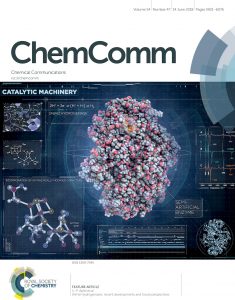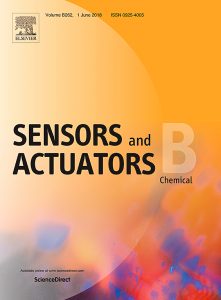Claudio Mazzoleni (Physics), Lynn Mazzoleni (Chem) and graduate student Simeon Schum were featured in the article “Aerosol problem: Adding a piece to the climate change puzzle,” in the Daily Mining Gazette.
Heather Powers is a Associate Director of Digital Content in University Marketing and Communications (UMC) at Michigan Technological University. Powers is responsible for all content aspects of UMC's recruitment and reputation web properties and proactively improves and maintains quality, benchmarks, and tests to innovate key sites and pages to meet integrated marketing, brand awareness and reputation, and recruitment goals.
 Stream gauges in the Keweenaw help us understand ecosystems and prepare our communities for flooding—but their existence is in jeopardy.
Stream gauges in the Keweenaw help us understand ecosystems and prepare our communities for flooding—but their existence is in jeopardy.
One of the most basic characteristics used to describe a stream is how much water it carries—the flow, or more accurately, discharge—which is measured in units of volume per time (typically cubic feet or cubic meters per second). Understanding how river discharge changes with time tells us important information about the stream, including how quickly something that is added to the river will be diluted and moved downstream. A river’s discharge rate also tells us how prone the river is to disturbances and what conditions the organisms that live there experience.
Understanding the river flow is also key for human communities. It allows planning for how quickly we can expect lakes and reservoirs to fill and how much water can be withdrawn for irrigation or drinking.
River flow also helps communities prepare for potential natural disasters, such as understanding how likely a river is to overflow its banks to cause a flood, and how to build culverts and bridges to withstand a flood like the one that Houghton experienced in June.
Read the full story on Unscripted.
We are happy to announce chemistry grad students Mingxi Fang and Xin Yan are among the winners for the Doctoral Finishing Fellowship Award. Congratulations!
Finishing Fellowships provide support to PhD candidates who are close to completing their degrees. These fellowships are available through the generosity of alumni and friends of the University. They are intended to recognize outstanding PhD candidates who are in need of financial support to finish their degrees and are also contributing to the attainment of goals outlined in The Michigan Tech Plan.
 According to a recent article in C&EN, the world wide, the chemical industry looks to be very healthy, with combined sales increasing by over 12% in 2017 over the prior year for its list of Global Top 50 chemical companies.
According to a recent article in C&EN, the world wide, the chemical industry looks to be very healthy, with combined sales increasing by over 12% in 2017 over the prior year for its list of Global Top 50 chemical companies.
 Sarah Green was quoted in the story “En cette moitié de 2018, les données du changement climatique ne sont pas rassurantes,” on TuxBoard.
Sarah Green was quoted in the story “En cette moitié de 2018, les données du changement climatique ne sont pas rassurantes,” on TuxBoard.
 Research scientists Yibin Zhang and Yanbo Zeng, PhD students Shuai Xia, Mingxi Zhang and Wafa Mazi, undergraduate students Taylor Johnston and Adam Pap and faculty members Rudy Luck and Haiying Liu published a paper entitled “New Near-infrared Rhodamine Dyes with Large Stokes Shifts for Sensitive Sensing of Intracellular pH Changes and Fluctuations” in Chemical Communications.
Research scientists Yibin Zhang and Yanbo Zeng, PhD students Shuai Xia, Mingxi Zhang and Wafa Mazi, undergraduate students Taylor Johnston and Adam Pap and faculty members Rudy Luck and Haiying Liu published a paper entitled “New Near-infrared Rhodamine Dyes with Large Stokes Shifts for Sensitive Sensing of Intracellular pH Changes and Fluctuations” in Chemical Communications.
This research is supported by the National Institute of General Medical Sciences of the National Institutes of Health under Award Number R15GM114751.
 Sarah Green (Chem/GLRC) was quoted in the article “You just lived through the hottest May on record in the contiguous U.S.” in Mashable.
Sarah Green (Chem/GLRC) was quoted in the article “You just lived through the hottest May on record in the contiguous U.S.” in Mashable.
 Michigan Tech Career Services will host a Chemical Engineering and Chemistry Virtual Career Fair from 1 to 4 p.m. tomorrow (April 11) using Brazen virtual technologies.
Michigan Tech Career Services will host a Chemical Engineering and Chemistry Virtual Career Fair from 1 to 4 p.m. tomorrow (April 11) using Brazen virtual technologies.
There are 12 employers registered for the fair, including PepsiCo, 3M, Exxon Mobil Corporation, The Estee Lauder Companies and Pfizer. From manufacturing to fashion and pharmaceuticals to food & beverage, there are many industries seeking students with chemistry-related majors.
Worcester Polytechnic Institute, Illinois Institute of Technology and Clarkson University students are also invited to participate.Virtual career fairs let participants chat with employers in real time from any desktop, laptop, smartphone or table with browser capabilities. Registration is now open.
 Haiying Liu, Marina Tanasova (Chem), visiting scholar Jianbo Wang, graduate students Shuai Xia, Jianheng Bi, Mingxi Fang and Wafa Mazi and undergraduate students Tyler Philips, Aslan May and Nathan Conner published “Fluorescent Probes Based on π-Conjugation Modulation between Hemicyanine and Coumarin Moieties for Ratiometric Detection of pH Changes in Live Cells with Visible and Near-infrared Channels” in Sensors and Actuators B: Chemical. This research is supported by NIH.’
Haiying Liu, Marina Tanasova (Chem), visiting scholar Jianbo Wang, graduate students Shuai Xia, Jianheng Bi, Mingxi Fang and Wafa Mazi and undergraduate students Tyler Philips, Aslan May and Nathan Conner published “Fluorescent Probes Based on π-Conjugation Modulation between Hemicyanine and Coumarin Moieties for Ratiometric Detection of pH Changes in Live Cells with Visible and Near-infrared Channels” in Sensors and Actuators B: Chemical. This research is supported by NIH.’
